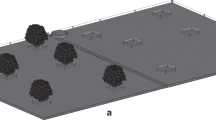Abstract
Information is needed on microclimatic differences present in different landscapes, such as open-pasture versus silvopasture, in the Southeast USA. This research tested a hypothesis that microclimatic conditions in mature-pine silvopasture would be milder compared to open-pasture. The research objective was to quantify microclimatic differences between mature-pine silvopasture and open pasture. The research was conducted in a loblolly-pine (Pinus taeda L.)-bahiagrass (Paspalum notatum Flugge) silvopasture and an open bahiagrass pasture, 5-ha each, in Chipley, Florida. Microclimatic parameters (air temperature, soil temperature at 5- and 10-cm depths, wind speed, gust speed, wind direction, humidity, dew point, rainfall, soil-moisture content, total solar radiation, and photosynthetically active radiation) were collected from November 2005 to January 2008 using HOBO© weather stations located in each pasture type. Data were analyzed to determine overall, as well as seasonal, monthly, and diurnal differences between pasture types. Evapotranspiration was calculated from air temperature, wind speed, relative humidity, and total solar radiation. The overall average values for all microclimatic parameters were lower in silvopasture compared to open-pasture. Seasonal, monthly, and diurnal differences between pasture types were also detected for several parameters. These results indicate that milder microclimatic conditions occur in silvopasture versus open-pasture on the Coastal Plain of the Southeast USA.

Similar content being viewed by others
References
Clason TR, Sharrow SH (2000) Silvopastoral practices. In: Garrett et al. (eds) North American agroforestry: an integrated science and practice. ASA, Inc., Madison
FAO online resource. http://www.fao.org/docrep/X0490E/x0490e08.htm. Accessed 15 June 2014
Gaughan JB, Lacetera N, Valtorta SE, Khalifa HH, Hahn L, Mader T (2009) Response of domestic animals to animal challenges. In: Ebi KL, Burton I, Mcgregor GR (eds) Biometeorology for adaptation to climate variability and change. Springer, Dordrecht
Johnson AJ, Wichern DW (2002) Applied multivariate statistical analysis. Prentice Hall, Englewood Cliffs
Karki U, Goodman MS (2010) Landscape use by cattle in silvopasture versus open pasture. Agrofor Syst 78:159–168. doi:10.1007/s10457-009-9250-x
Karki U, Goodman MS (2013) Microclimatic differences between young long-leaf pine silvoasture and open-pasture. Agrofor Syst 87(2):303–310. doi:10.1007/s10457-012-9551-3
Littell RC, Stroup WW, Freund RJ (2005) Sas® for linear models. John Wiley & Sons Inc, Cary
Rawat L, Raturi AS, Pande SK, Bhattacharya MK (1993) Effects of Eucalyptus windbreaks on microclimate of a mango orchard in Saharanpur District (U.P.). Van Vigyan 31:55–58
Rietveld WJ, Francis CA (2000) The future of agroforestry. In: Garrett HE (ed) North American Agroforestry: an integrated science and practice, 2nd edn. ASA Inc, Madison, pp 387–402
USDA, United States Department of Agriculture (2013) Climate change and agriculture in the United States: Effects and adaptation. http://www.usda.gov/oce/climate_change/effects_2012/CC%20and%20Agriculture%20Report%20(02-04-2013)b.pdf. Accessed 13 Sept 2014
USDA-ERS, United States Department of Agriculture, Economic Research Service (2012) Major uses of land in the United States, 2007. http://www.ers.usda.gov/publications/eib-economic-information-bulletin/eib89.aspx. Accessed 21 June 2014
Valigura RA, Messina MG (1994) Modification of Texas clear-cut environments with loblolly pine shelterwoods. J Environ Manage 40:283–295
Van Miegroet HV, Hysell MT, Johnson AD (2000) Soil microclimate and chemistry of spruce-fir tree islands in Northern Utah. Soil Sci Soc Am J 64:1515–1525
Acknowledgments
The authors acknowledge the generous cooperation of Mr. George Owens, Owens’ Farm, Chipley, Florida for access to his property for location of weather stations, and the Southern Sustainable Agriculture Research and Education Program (SSARE) for financial support.
Author information
Authors and Affiliations
Corresponding author
Additional information
At the time of the research, Karki was a graduate research assistant, Department of Agronomy and Soils, Auburn University, Auburn, AL 36849-5412, USA.
Mary S. Goodman—is retired.
Rights and permissions
About this article
Cite this article
Karki, U., Goodman, M.S. Microclimatic differences between mature loblolly-pine silvopasture and open-pasture. Agroforest Syst 89, 319–325 (2015). https://doi.org/10.1007/s10457-014-9768-4
Received:
Accepted:
Published:
Issue Date:
DOI: https://doi.org/10.1007/s10457-014-9768-4




